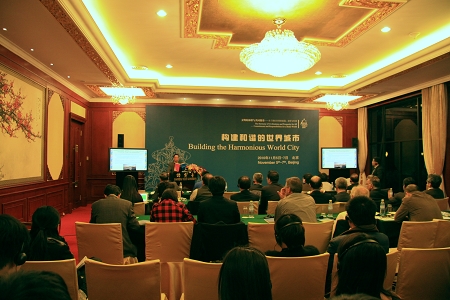Peking University, Nov. 8, 2010: On the afternoon of Nov. 5, the panel session around the theme of "Building the Harmonious World City" raised the curtain at Diaoyutai State Guest House with scholars from around the globe present. The cases of some Chinese cities attracted their particular attention.

Panel Session of "Building the Harmonious World City" at the VIP Room,
Bafang Garden, Diaoyutai State Guest House
"On the way to becoming a world city, Beijing has fallen into a 'trap,'" Prof. Yang Kaizhong from Peking University pointed out the paradoxes of the developing metropolis . According to his explanation, the Chinese government showed less interest in world cities' ability to command and control than the Western World did — instead, the productivity of all kinds, including labor, capital, and environment was specially emphasized in the 12th Five-Year Plan. The productivity was regarded as equivalent to the ability to influence or compete. "Nowadays, Beijing is facing more and more challenges, especially the stagnation of development," Prof. Yang commented. He listed some suggestions -- to rely on a multi-center urban region around, to tighten the access policy, and to put forward an innovative city strategy.
However, Prof. Gu Chaolin viewed the case of Beijing from a totally different angle. This geologist from Tsinghua University thoroughly described the great change of Beijing's landmarks, which typically symbolized the city's rapid internationalization. Meanwhile, he revealed the tough problems behind the booming, such as social justice, environmental protection, cultural industrialization, and rational planning to name a few. "How will it affect China and the world if the urban expansion continues?" he left the question worthy of consideration.
Another example mentioned was Shanghai. Prof. Zhu Jieming from Singapore compared the largest city in China with his city-state in order to illustrate his theory of what the government should do to nurture a world city --"first providing a favorable policy climate, then the construction of harmonious communities". As he concerned most, the influx of international talents would occupy the local working opportunities, arouse contradiction, and consequently undermine social stabilitywhich seemed a headache to the administrators.
Prof. Shen Jianfa from the Chinese University of Hong Kong (CUHK) talked about the relationship between Hong Kong Special Administrative Region and Pearl River Delta. By reviewing the history, he predicted that HK would keep its leading position ,though not uniquely, in China in the foreseeable future as long as it kept in close contact with the mainland.
In addition to the Chinese cities above, there were also some general topics. Prof. Takatoshi Tabuchi from the University of Tokyo analyzed the trade and transportation factors which played key roles in urban development. Prof. Emmanuelle Auriol from University of Toulouse, France, appealed to the emerging markets for more hi-tech innovations as well as better intellectual property rights (IPR) protection. Similarly, Prof. Kiyoshi Kobayashi from Kyoto University highlighted the idea of "innovative cities", such as Seoul, Tokyo, and other cities in East Asia.
During the Q&A section, the lectures detailed their various points of view in response to the questions from the audience.
Extended Reading:
PKU News (Chinese): Whither Goest Thou, "World City" in the New Age?
Reported by: Jin Ludi
Edited by: Chen Miaojuan